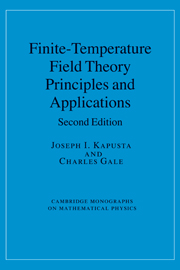Book contents
- Frontmatter
- Contents
- Preface
- 1 Review of quantum statistical mechanics
- 2 Functional integral representation of the partition function
- 3 Interactions and diagrammatic techniques
- 4 Renormalization
- 5 Quantum electrodynamics
- 6 Linear response theory
- 7 Spontaneous symmetry breaking and restoration
- 8 Quantum chromodynamics
- 9 Resummation and hard thermal loops
- 10 Lattice gauge theory
- 11 Dense nuclear matter
- 12 Hot hadronic matter
- 13 Nucleation theory
- 14 Heavy ion collisions
- 15 Weak interactions
- 16 Astrophysics and cosmology
- Conclusion
- Appendix
- Index
10 - Lattice gauge theory
Published online by Cambridge University Press: 04 November 2009
- Frontmatter
- Contents
- Preface
- 1 Review of quantum statistical mechanics
- 2 Functional integral representation of the partition function
- 3 Interactions and diagrammatic techniques
- 4 Renormalization
- 5 Quantum electrodynamics
- 6 Linear response theory
- 7 Spontaneous symmetry breaking and restoration
- 8 Quantum chromodynamics
- 9 Resummation and hard thermal loops
- 10 Lattice gauge theory
- 11 Dense nuclear matter
- 12 Hot hadronic matter
- 13 Nucleation theory
- 14 Heavy ion collisions
- 15 Weak interactions
- 16 Astrophysics and cosmology
- Conclusion
- Appendix
- Index
Summary
Perturbation theory applied to QCD predicts that the normally strong interactions among quarks and gluons become weak at high temperatures and densities on account of asymptotic freedom. This leads to a state known as quark–gluon plasma. The perturbative analysis of QCD was the subject of the last two chapters. At low temperatures and densities quarks and gluons are not observed individually but only as color-neutral objects, hadrons, on account of confinement. Then hadrons are the relevant degrees of freedom, just as atoms and molecules are the relevant degrees of freedom in biological physics. Nuclear matter and hot hadronic matter are the subjects of the next two chapters. The standard computational method for studying QCD in the transitional region is lattice gauge theory.
Lattice gauge theory is a field of intellectual study in itself. It is not possible in one chapter to cover it in all detail, not the least reason being that it is numerically quite involved. We will introduce the basic theoretical ideas and the main numerical results. As the field is evolving owing to rapid increases in computational power, these results will no doubt be superseded in the near future. Nevertheless, the main conclusions should stand the test of time.
The formulation of nonabelian gauge theories on a spacetime lattice in Euclidean space was introduced by Wilson with the purpose of studying quark confinement. The infinite-dimensional functional integral that defines a quantum field theory becomes a finite-dimensional integral when the lattice has a finite extent in space and time and is therefore unambiguously defined.
- Type
- Chapter
- Information
- Finite-Temperature Field TheoryPrinciples and Applications, pp. 195 - 218Publisher: Cambridge University PressPrint publication year: 2006



